Plants with White Flowers
White flowers can be found in many plant families; in the spring they are commonly found in the chickweed and mouse-ear family - small to very small plants with five-petalled flowers that can be obvious as early as late February or early March. In early summer, shrubs with white flowers are common, especially in the rose family.
As well as flower colour, it is important to take careful note of the exact petal shape - are the petals rounded, or do they came to a sharp point, for example; are there gaps between the petals or do they overlap; are the flowers solitary, or arranged in spikes or bunches.
If you are struggling to identify a white flower, it is worth bearing in mind that white colour forms of normally red or blue-flowered species
occur from time to time and can even be quite frequent in some plant populations; where I have pictures of these, they are included in the guide. Such plants often occur as individuals within typically-coloured plants of the same species so it is always worth looking at what else is in the immediate area.
Within the colour sections, the pictures are grouped so that similar-looking (though not necessarily closely-related) plants will be near each other.
This should help to reduce your search time. To keep things concise, not all species are shown in the colour keys, so you may have to go for a 'best match' to get you through to the next stage of the identification process. Particularly in large families where there are a number of very similar species, a representative species is shown here, but clicking on it will take you to a page that tells you how to tell the more difficult species apart.
Many plants will be obviously one colour or another, obviously five petalled, or obviously a woody shrub, etcetera. But many will be debatable. In such cases, I have tried to imagine how a flower might be perceived by others, especially beginners to plant identification. Generally this results in a plant appearing in more than one place on these pages, but some still remain problematic. In particular, the section labelled 'tubular flowers' contains a variety of flowers that might be considered to fall into that category and these generally have petals that are fused together to fully surround the sexual parts of the flower. But these tubes might be elongate like a pencil, or broad and bell-like. Flowers of two colours are entered under the colour that covers most of the flower, but truly bicoloured flowers may be entered under both colours. Woody plants with green stems that might not be considered woody, are entered under their flower colour or shape, as well as under the woody plants sections.
If you still can't find your plant, you either have something very interesting that you may wish to tell me about, or I just haven't got a picture
of it yet - I'm still working on the latter!!
Click on the pictures below to go to the species pages.
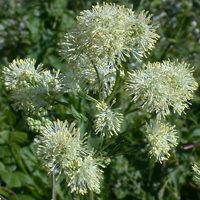 |
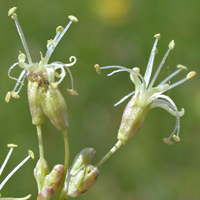 |
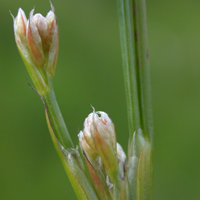 |
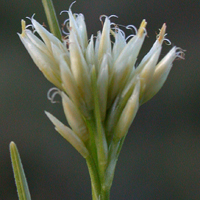 |
Meadow-rues - Spreading heads of many whitish flowers, in damp meadows
|
Spanish Catchfly - Spindly, upright spikes of cream-coloured flowers; rare, in Breckland
|
Rushes - Appearing petalless, with whitish, papery bracts around tiny clusters of flowers on long, grass-like stems. Usually in wet places
|
White Beak-sedge - Small, petalless flowers in a tight head above grass-like stems, rare in acid bogs
|
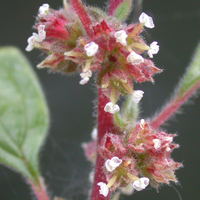 |
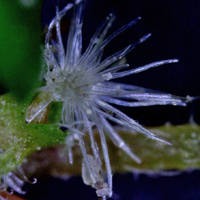 |
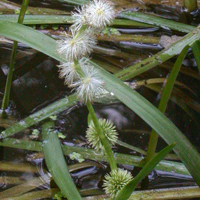 |
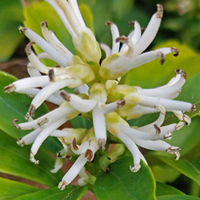 |
Pellitory-of-the-wall - Masses of tiny red/green, petalless flowers with white tips, crowded at the leaf bases. On walls, cracks in pavement and similar places
|
Mind-your-own-business - Flowers so tiny as to be almost invisible without a hand lens, in axils of leaves. Plant with tiny leaves, creeping on walls and pavement edges
|
Bur-reeds - White 'pompoms' in a spike, above sword-like leaves, growing in water or very wet ground
|
Carpet Box - Creeping, groundcover plants with whorled leaves
|
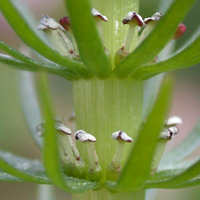 |
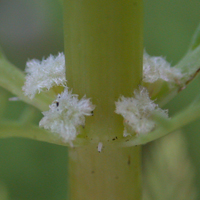 |
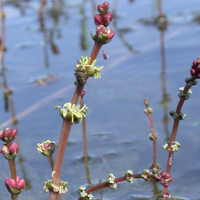 |
 |
Mare's-tail - Tiny (hand lens!) flowers in whorled leaf axils on succulent stems, growing in water or water-logged ground
|
Parrot's-feather - Tiny, petalless flowers in the axils of feathery leaves. Plant in or close to water
|
Water-milfoils - Spikes of tiny, whitish flowers arising from water; plants mostly submerged
|
Plume-poppies - Petalless flowers with hanging, white stamens, carried in large, frothy heads
|
 |
Castor-oil-plant - Vigorous plants with palmate leaves; female flowers green and spikey, male flowers in bundles of creamy stamens
|
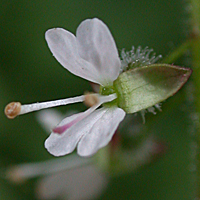 |
Enchanter's Nightshades - Tiny flowers on a thin, spindly flower spike, in woods and shady places
|
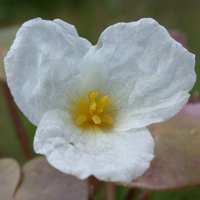 |
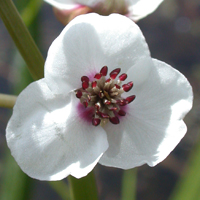 |
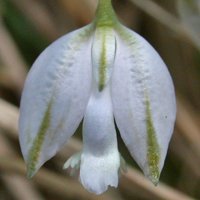 |
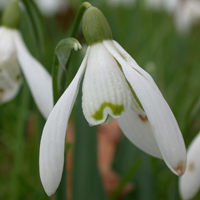 |
Waterweeds - Trailing or spreading plants, growing in water or on very wet ground
|
Water-plantains - Upright plants, growing from water or very wet ground
|
Milkworts - Small spikes of white, pink or blue flowers, each flower with the middle petal rolled into a thin tube and with a tiny, pale beard
|
Snowdrops - Winter and early spring flowers with three obvious, outer petals but also three, shorter, inner petals
|
 |
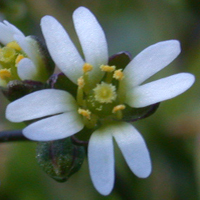 |
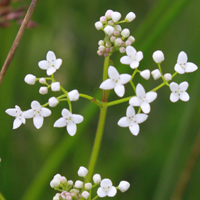 |
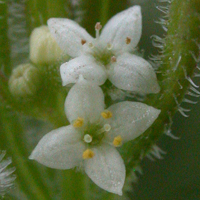 |
Cabbage Family - Small flowers, usually in a clustered head
|
Cresses - Tiny flowers with deeply-cleft petals on wiry, slender stems
|
Bedstraws - Small, cream or white flowers in clusters on plants with leaves in whorls of four to six
|
Bedstraws - Small, cream or white flowers in clusters on plants with leaves in whorls of four to six
|
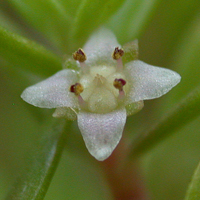 |
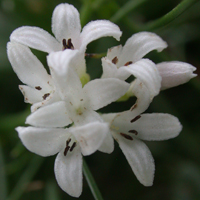 |
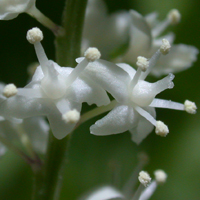 |
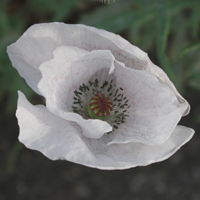 |
New Zealand Pygmyweed - Tiny flowers on mat-forming plants in ponds or very wet ground
|
Squinancywort - Flowers in small bundles, with recurved petals; in limestone grassland
|
May Lily - Tiny flowers, clustered in an upright spike on low, creeping plants. Rare
|
Poppies - Large, flimsy petals that greatly overlap - flowers usually red
|
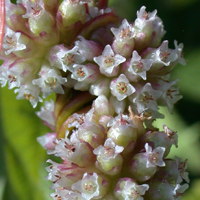 |
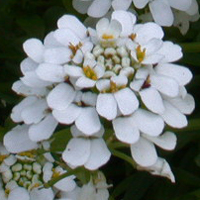 |
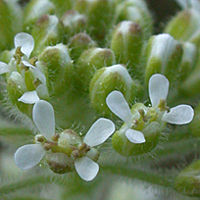 |
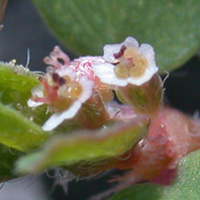 |
Dodders - Tight, spiral masses of small flowers on reddish stems, twisting around other plants
|
Candytufts - Neat, rounded heads of pure white, asymmetrical flowers
|
Pepperworts - Tiny flowers with uneven-looking, tiny petals in clusters or elongated heads
|
Spurges - Tiny flowers with 4-5 rounded white glands that look like petals
|
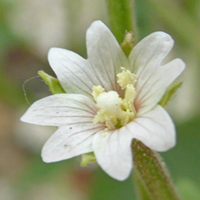 |
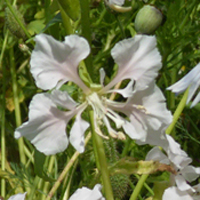 |
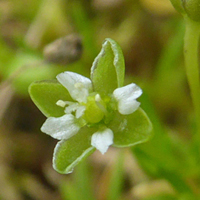 |
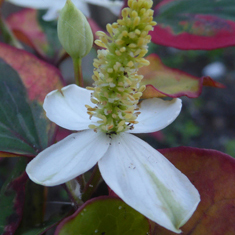 |
Willowherbs - Small herbaceous perennials in damp places or as weeds of disturbed ground
|
Clarkias - Upright annuals, the flowers with narrow-based petals and a long, tubular base that becomes the seedpod later
|
Pearlworts - Petals absent, or very tiny and much smaller than the green sepals
|
Fish-plant - Individual flowers petalless, but carried in a spike above four to six, petal-like bracts
|
 |
White Beeblossom - Upright, herbaceous perennials with flowers well spaced along slender branches
|
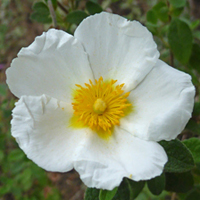 |
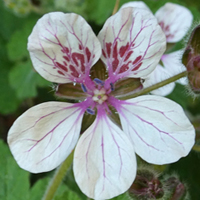 |
Rock-roses - Low, evergreen subshrubs with delicate, thin petals
|
Stork's-bills - Escaping garden ornamental with petals bearing reddish blotches
|
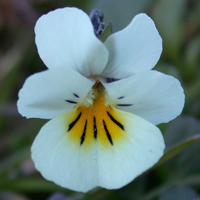 |
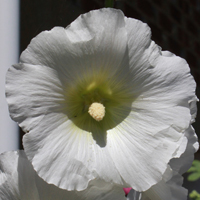 |
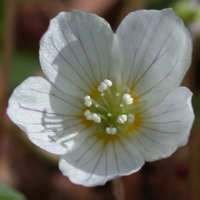 |
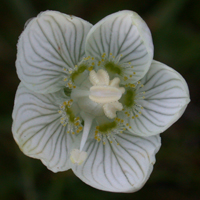 |
Pansies & Violets - Small but showy flowers, with or without yellow or purple
|
Hollyhocks - Large, rounded flowers in a very tall spike above rounded leaves
|
Wood Sorrel - Creeping woodland plant with trifoliate leaves
|
Grass-of-Parnassus - Broad petals with obvious veins; rare in wet ground
|
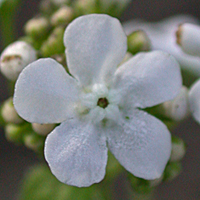 |
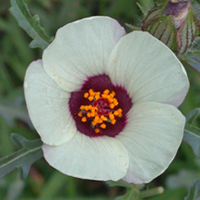 |
 |
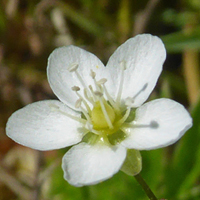 |
White forget-me-nots - Flowers with rounded petals that are fused into a tube lower down
|
Bladder Ketmia - Showy little flowers, with a dark centre on plants with fingered leaves
|
Spurges - Tiny flowers with 4-5 rounded white glands that look like petals
|
Pearlworts - Small, moss-like plants with needle-like leaves
|
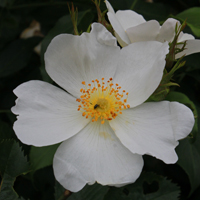 |
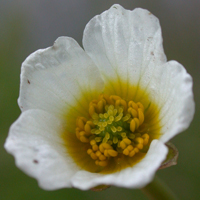 |
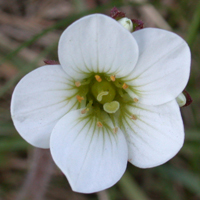 |
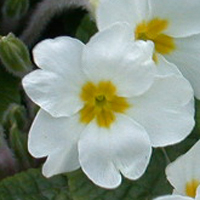 |
Rose Family - Showy, five-petalled flowers on thorny bushes
|
Water-crowfoots - Plant floating in water or growing on very wet ground
|
Saxifrages - Showy flowers above slightly fleshy leaves
|
Primroses - Spring-flowering; flowers usually pale yellow
|
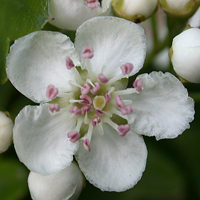 |
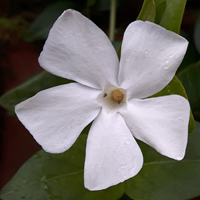 |
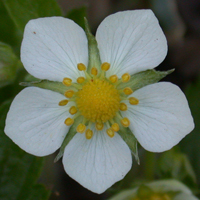 |
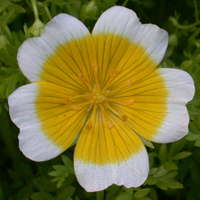 |
Rose Family - Small bunches of five-petalled flowers with many stamens at the centre, on woody trees and shrubs, especially in hedgerows
|
Periwinkles - Showy flowers on trailing stems that form spreading colonies
|
Strawberries & allies - Low-growing plants, usually with three- or five-parted leaves
|
Meadow-foam - Flowers yellow and white like poached eggs
|
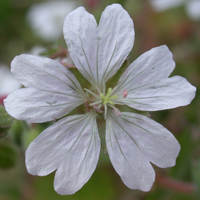 |
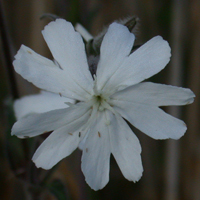 |
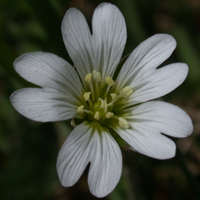 |
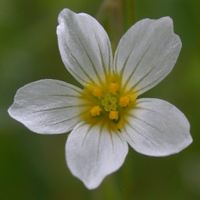 |
Crane's-bills - Petals notched or cleft at the tip; flowers usually pink, occasionally white
|
Campions - Petals broad and deeply notched
|
Mouse-ears - Deeply cleft petals on low-growing plants with simple, hairy leaves
|
Fairy Flax - Tiny flowers on very slender, wiry stems
|
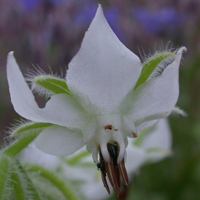 |
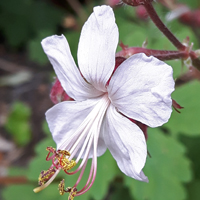 |
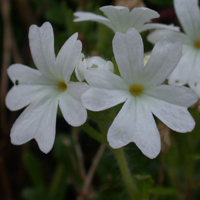 |
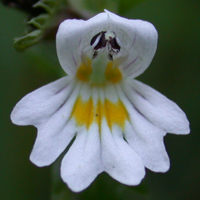 |
Borage - Star-shaped, nodding flowers on roughly hairy plants
|
Rock Crane's-bill - Flowers with long and obvious stamens; hairy plant with a pungent smell
|
Fairy Foxglove - Five irregular-shaped petals on small plants growing from walls; rare
|
Eyebrights - Small but showy flowers on upright stems; five petals fused into a tube at the base
|
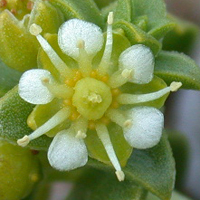 |
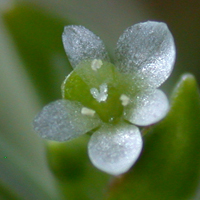 |
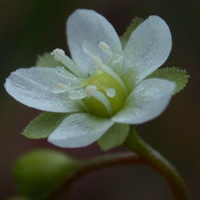 |
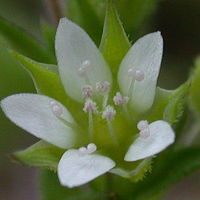 |
Sea Sandwort - Low, succulent-leaved plants on coastal beaches and saltmarsh edge
|
Blinks - Tiny flowers (hand lens required) with often uneven or misshappen petals, on small, creeping plants
|
Sundews - A slender spike of few flowers above sticky leaves; in sphagnum bogs
|
Sandworts - Narrow petals with long, pointed sepals
|
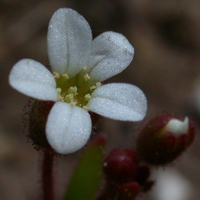 |
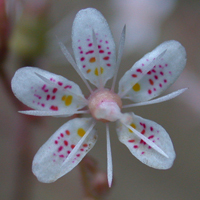 |
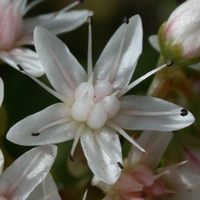 |
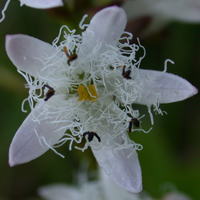 |
Saxifrages - Tiny flowers above slightly fleshy leaves
|
Saxifrages - Tiny flowers with red spots above slightly fleshy leaves
|
Stonecrops - Flowers in heads with long, obvious stamens, above succulent leaves
|
Bogbean - Clustered heads of five-petalled flowers with a shaggy centre; plants of shallow water or wet bogs
|
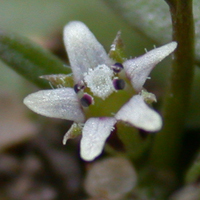 |
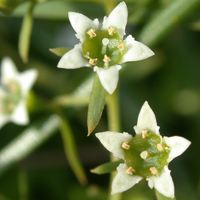 |
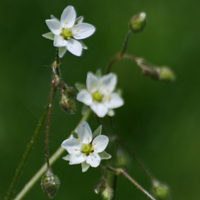 |
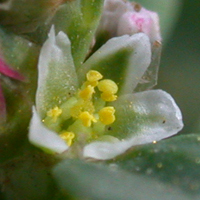 |
Mudwort - Tiny (hand lens!) flowers among spoon-shaped leaves, in wetlands; very rare
|
Western Bastard-toadflax - Small, stiff flowers on low, sprawling stems. Very rare in chalk grassland
|
Corn Spurrey - Starry flowers above slightly fleshy, needle-like leaves
|
Knotgrasses - Small flowers on low, mat-forming plants. Petals with green stripes
|
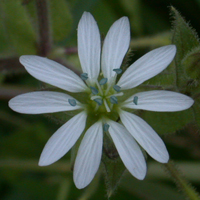 |
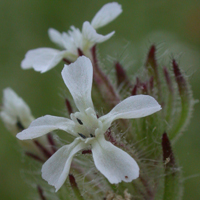 |
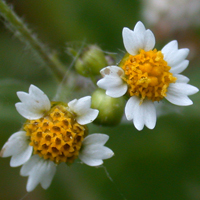 |
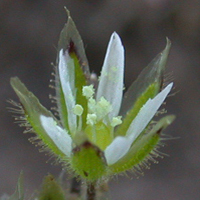 |
Chickweeds
& Stitchworts - Five petals deeply cleft so as to appear like 10 petals
|
Small-flowered
Catchfly - Narrow petals on stickily-hairy plants
|
Daisy Family - Compound heads of many flowers, but appearing as if having five, toothed petals
|
Mouse-ears - Petals smaller than the green sepals; plants often very small
|
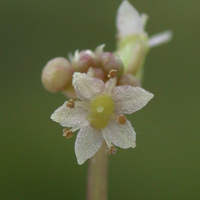 |
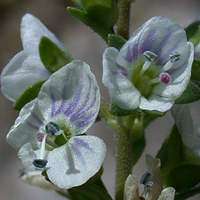 |
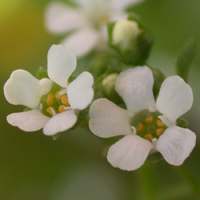 |
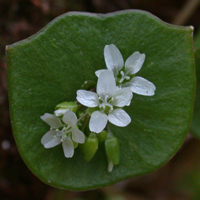 |
Pennyworts - Tiny (hand lens!) flowers hidden below round leaves, in wetlands
|
Speedwells - Creeping plants with small spikes of lilac-veined flowers
|
European Brookweed - Tiny flowers on slender plants, in wetlands
|
Perfoliate Springbeauty - Small clusters of flowers, backed by a rounded, shield-like leaf bract
|
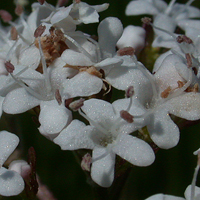 |
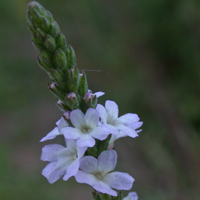 |
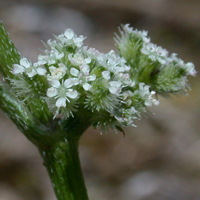 |
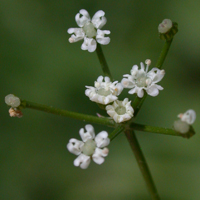 |
Valerians - Many flowers in rounded or flattened heads; often in wet ground
|
Common Vervain - Flowers in upright spikes which continue to elongate as the flowers mature
|
Umbellifers - Tight heads of small flowers opposite feathery leaves along the main stem
|
Umbellifers - Open heads of small flowers on spreading stalks
|
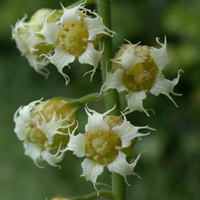 |
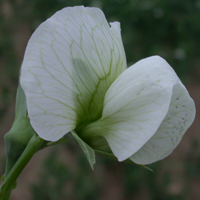 |
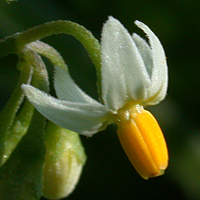 |
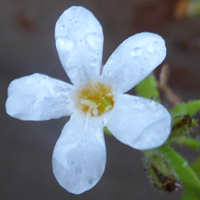 |
Fringecups - Cream-coloured flowers with bristle-edged petals in narrow, upright spikes
|
Peas & Vetches - Broad petals, the upper one the largest, the lower two fused to form a boat-shaped 'keel'
|
Nightshades - Petals reflexed, prominent yellow centres
|
Bacopa - Flowers with a tubular base and yellow in the centre, on low, trailing plants
|
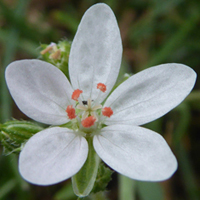 |
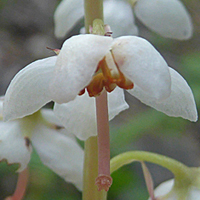 |
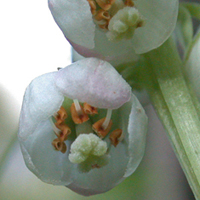 |
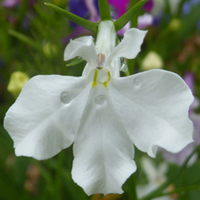 |
Stork's-bills - Low-growing plants with deeply cut, pinnate leaves
|
Wintergreens - Small plants with a rosette of basal leaves and a single spike of flowers that have long-protruding stigmas
|
Wintergreens - Small plants with a rosette of basal leaves and a single spike of globular flowers
|
Fairy Lobelia - Tiny plants with showy flowers, self-seeding from hanging baskets
|
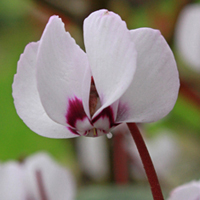 |
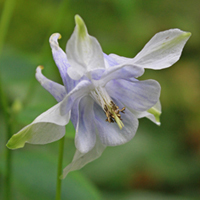 |
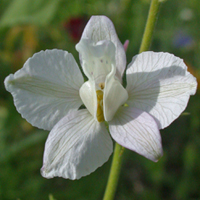 |
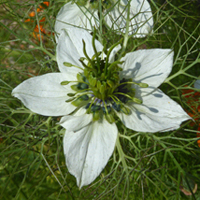 |
Cyclamens and sowbreads - Petals reflexed back on themselves, often appearing above ground without the leaves
|
Columbines - Complicated flowers with five petals and five petal-like sepals; petals have long nectar spurs at back. Colour may be any shade of blue, purple, pink, or even white
|
Larkspurs - Five petal-like sepals, with the true petals fused into a small 'cup' in the centre of the flower; flowers various shades of blue, pink or white in an upright spike above feathery foliage
|
Love-in-a-mist - Five petal-like sepals among fine, filigree foliage; annuals of disturbed ground
|
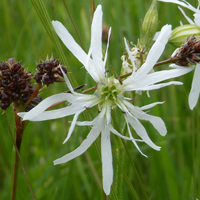 |
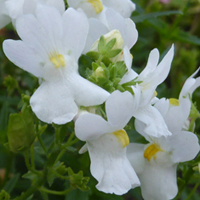 |
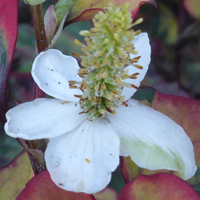 |
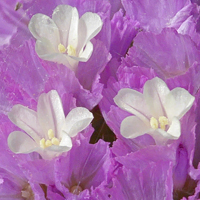 |
Ragged-Robin - Petals very deeply cut and ragged
|
Cape Snapdragon - Petals unequal in size and shape and forming a short spur at the back
|
Fish-plant - Individual flowers petalless, but carried in a spike above four to six, petal-like bracts
|
Statice - Branched heads of many, small (white) flowers surrounded by large, petal-like, coloured bracts
|
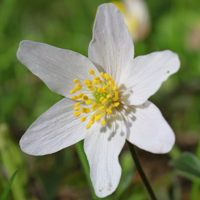 |
 |
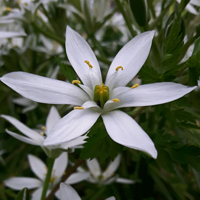 |
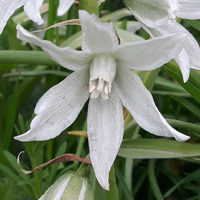 |
Wood Anemone - Low, mat-forming in woods and shady places
|
Onions & Garlics - Several to many flowers on single stalks, but all emerging from the top of a common stalk
|
Common Star-of-Bethlehem - Several flowers in a spike, petals with green stripe on back
|
Drooping Star-of-Bethlehem - Several flowers in a spike, petals with green stripe on back
|
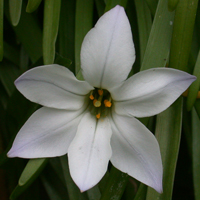 |
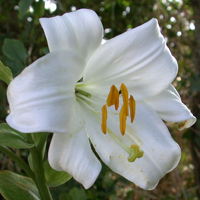 |
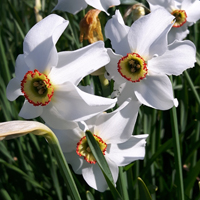 |
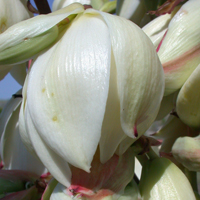 |
Spring Starflower - Petals often pinkish on bank, leaves grass-like, in a clump
|
Lilies - Large, 'blousy' flowers, often sweet-scented
|
Daffodils - Six, white, outer petals with inner petals of varying colour
|
Spanish-dagger - Impressive, large clusters of flowers, atop fleshy, sword-like leaves
|
 |
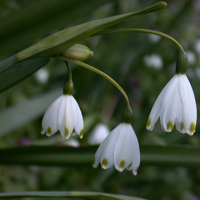 |
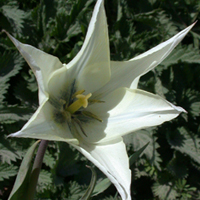 |
Common Snowdrop - Winter and early spring flowers with three longer, outer petals and three, shorter, inner petals
|
Summer
Snowflake - Tubular flowers in small clusters atop long, leaning stems
|
Tulips - Spring flowering from bulbs, flowers in a wide range of colours, single atop a slender stem
|
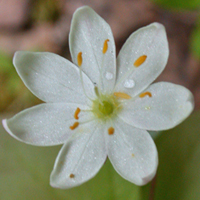 |
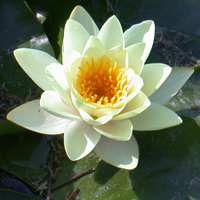 |
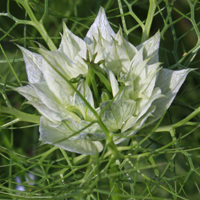 |
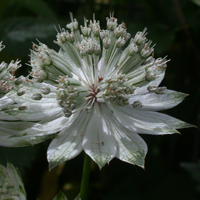 |
Chickweed-wintergreen - A single flower atop a slender stalk with a whorl of 5-6 leaves beneath
|
Water-lilies - Showy flowers, floating on water surface in ponds
|
Love-in-a-mist - Ten petal-like sepals among fine, filigree foliage. Flowers usually blue
|
Masterworts - Many petal-like bracts around a head of many small flowers clustered in the centre
|
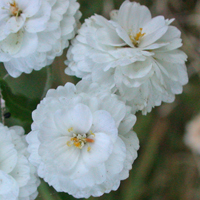 |
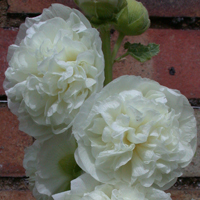 |
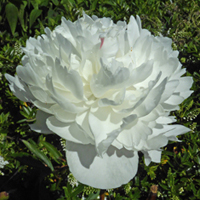 |
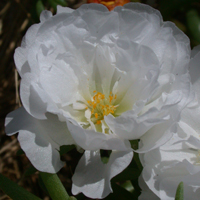 |
Sneezewort - Small pompoms above narrow leaves with toothed edges
|
Hollyhocks - Pompom flowers in a very tall spike
|
Peonies - Large, showy flowers with floppy, broadly overlapping petals
|
Rose-moss - Pompom flowers on creeping plants with succulent, needle-like leaves
|
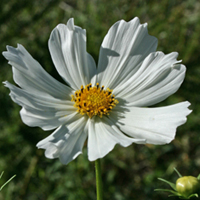 |
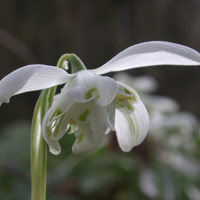 |
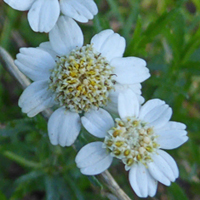 |
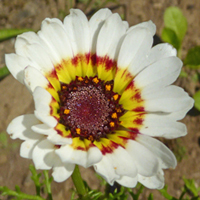 |
White-flowered daisies - Showy, daisy-like flowers with 8-10 petals and fine, feathery foliage
|
Snowdrops - Winter and early spring flowers with three, outer, long petals and an inner mass of shorter, curled petals
|
Sneezewort - Flowers with variable number of petals, but actually made up of many, smaller, flowers in a tight head
|
Tricolour Chrysanthemum - Showy daisy flowers with bands of different colours on the petals and deeply cut leaves
|
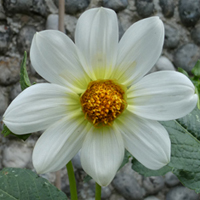 |
Dahlias - Showy daisy flowers with broad petals and pinnate, coarsely-toothed leaves
|
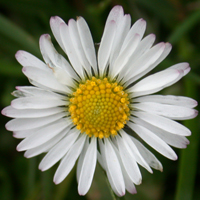 |
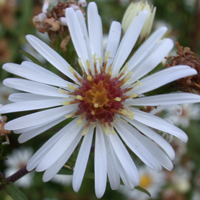 |
 |
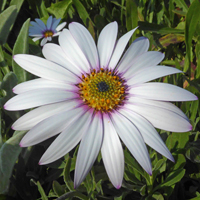 |
White Daisies - Flowerheads solitary on long stems or clustered in branched heads
|
Asters & Michaelmas-daisies - Spreading sprays of daisy-like flowers with yellow or brownish centres; various shades of pale blue, mauve or white
|
Tricolour Chrysanthemum - Showy daisy flowers with bands of different colours on the petals and deeply cut leaves
|
Cape Daisy - Large, showy flowers, the petals with darker undersides
|
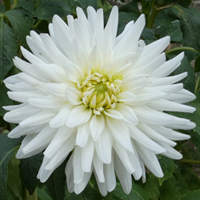 |
Garden Dahlia - Showy daisy flowers with ornamental petals and pinnate, coarsely-toothed leaves
|
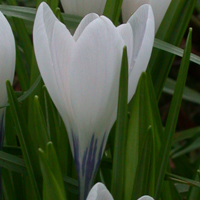 |
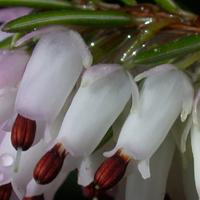 |
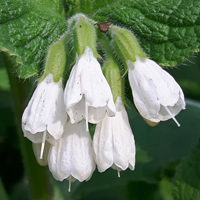 |
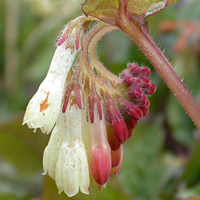 |
Crocuses - Six petals, free at the top but fused into a narrow tube lower down
|
Heaths - Showy clusters of hanging flowers with dark stamens; plants with needle-like leaves
|
Comfreys - Bunches of hanging flowers with large, roughly hairy leaves
|
Comfreys - Red buds turn white as the flowers open
|
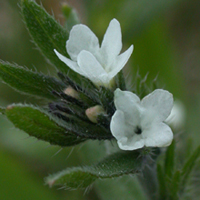 |
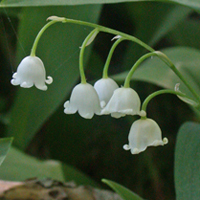 |
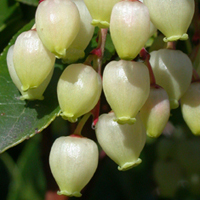 |
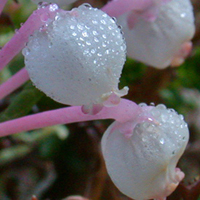 |
Gromwells - Flowers narrowly tubular at the base, opening to five petals at the mouth
|
Lily-of-the-valley - Bell-shaped, Six-petalled flowers in small clusters on low, groundcover plants
|
Heath Family - Woody, evergreen trees with flowers in tight bunches, followed by yellow or orange fruits
|
Heath Family - Creeping subshrubs of sphagnum bogs; very rare
|
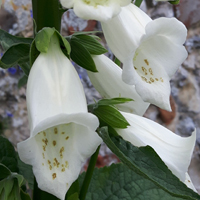 |
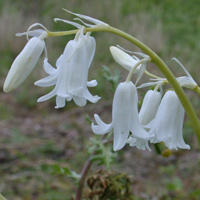 |
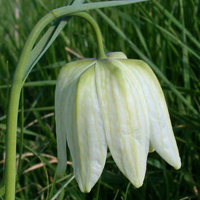 |
 |
Common Foxglove - Impressive tall spikes of drooping, funnel-shaped flowers, spotted on the inside
|
Bluebells - Tubular flowers with six petals
|
Snake's-head Fritillary - Six petals fused into a bell shape
|
Summer Snowflake - Six-petalled flowers in small clusters atop long, leaning stems
|
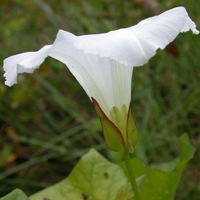 |
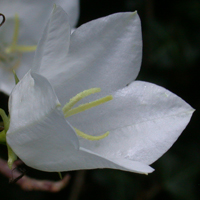 |
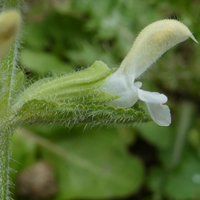 |
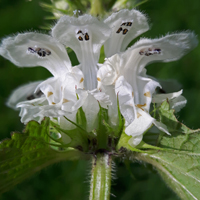 |
Bindweeds - Large, white, trumpet flowers on twining/sprawling stems
|
Bellflowers - Broadly bell-shaped flowers in upright spikes
|
White labiates - Narrow, tubular-based flowers opening into a two-lipped mouth
|
Dead-nettles - Clusters of tubular flowers, opening to a broad, two-lipped mouth; in whorls at the leaf bases
|
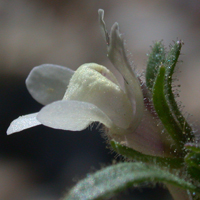 |
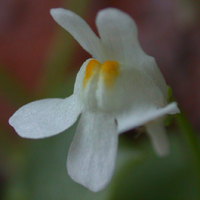 |
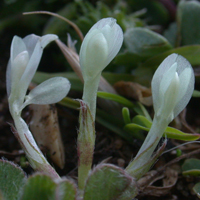 |
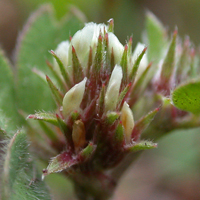 |
Toadflaxes & allies - Tubular flowers with five fused petals, opening into a five-lobed lip
|
Toadflaxes & allies - Tubular flowers with five fused petals, opening into a five-lobed lip
|
Clovers - Narrow, tubular flowers carried close to the ground on creeping plants with trifoliate leaves
|
Clovers - Narrow, tubular flowers in a tight, rounded head on creeping plants with trifoliate leaves
|
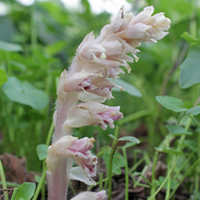 |
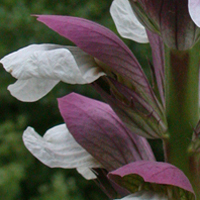 |
 |
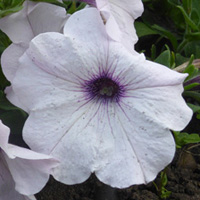 |
Common Toothwort - Tubular flowers in a one-sided spike, emerging from the ground with no green parts
|
Bear's-breeches - Tubular flowers surrounded by a maroon-purple hood, in upright spikes
|
Fairy Lobelia - Tiny plants with showy flowers, self-seeding from hanging baskets
|
Hybrid Petunia - Large, showy flowers with thin, floppy petals fused together into a tube at the base
|
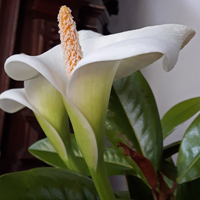 |
 |
 |
Altar-lily - Large, funnel-shaped flowers with a yellow, finger-like spike in the centre
|
Bleeding-hearts - Peculiar flowers with swollen bases and beak-like tips
|
Bleeding-hearts - Peculiar flowers with swollen bases and beak-like tips
|
 |
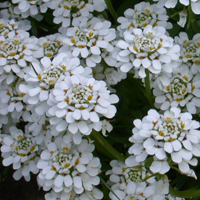 |
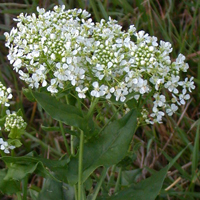 |
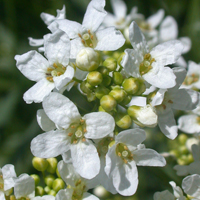 |
Bedstraws - Small, cream or white flowers, leaves in whorls of four to six
|
Candytuft - Neat, rounded heads of pure white, four-petalled flowers
|
Cresses - Frothy heads of four-petalled flowers
|
Cabbage Family - Four-petalled flowers in a short, upright flower spike
|
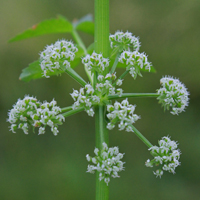 |
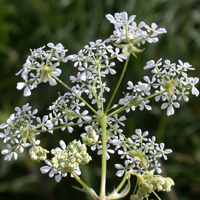 |
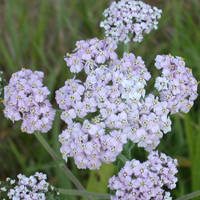 |
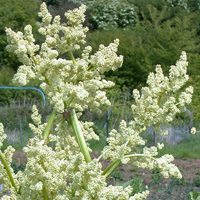 |
Umbellifers - Many clusters of small white flowers on the ends of radiating branchlets, like the spokes of an umbrella
|
Umbellifers - Many clusters of small white flowers on the ends of radiating branchlets, like the spokes of an umbrella
|
Yarrow - Many clusters of small white flowers in flat-topped heads, above feathery, fern-like foliage
|
Rhubarb - Huge, spreading flowerhead of tiny, creamy flowers above massive, crinkled leaves
|
 |
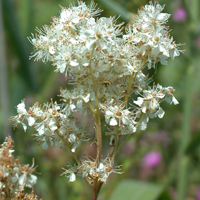 |
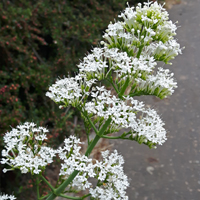 |
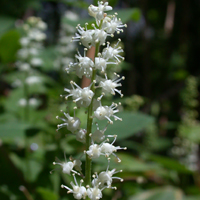 |
Meadow-rues - Spreading heads of many whitish flowers, in damp meadows
|
Meadowsweets - Open, fragrant heads of small, five-petalled flowers
|
Red Valerian - Large, tiered heads of small flowers with long spurs at the back; often in colonies of mixed pink, red and white-flowered plants
|
May Lily - Tiny flowers, clustered in an upright spike on low, creeping plants. Rare
|
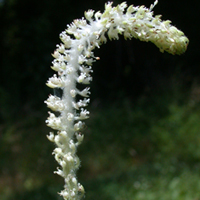 |
 |
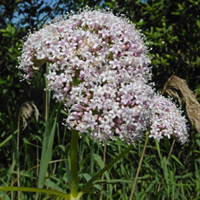 |
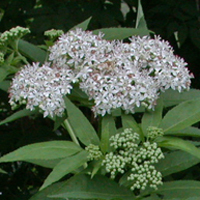 |
Lizard's-tail - Curved spike of many, tiny, petalless flowers
|
Common Toothwort - Tubular flowers in a one-sided spike, emerging from the ground with no green parts
|
Valerians - Tiny, five-petalled flowers in dense, flat or rounded heads - similar to elder but not woody shrubs
|
Elders - Flattened heads of creamy, five-petalled flowers above pinnate leaves
|
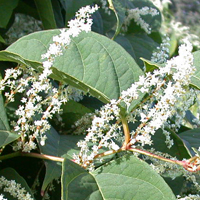 |
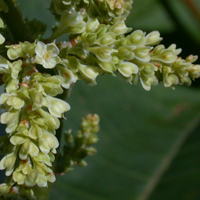 |
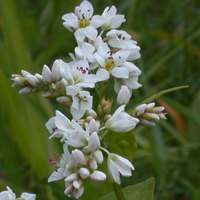 |
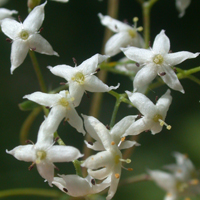 |
Knotweeds - Slender flower spikes on cane-like stems with large leaves
|
Knotweeds - Clustered flower spikes on cane-like stems with large leaves
|
Common Buckwheat - Showy heads of five-petalled flowers on knee-high plants with more or less triangular leaves
|
Bedstraws - Open clusters of delicate, four-petalled flowers; leaves in whorls of four to six
|
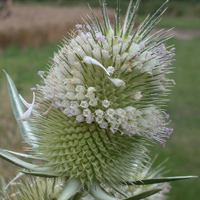 |
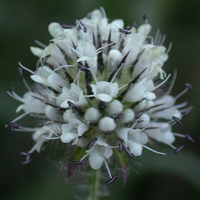 |
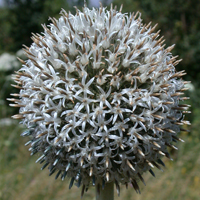 |
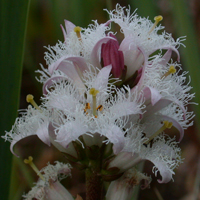 |
Teasels - Prickly, thistle-like plants with tiny flowers packed into a cone-shaped head
|
Teasels - Prickly, thistle-like plants with tiny flowers packed into a cone-shaped head
|
Globe-thistles - Tall, thistle-like plants with small flowers packed into a spherical head
|
Bogbean - Clustered heads of five-petalled flowers with a shaggy centre; plants of shallow water or wet bogs
|
 |
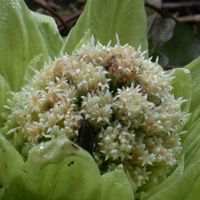 |
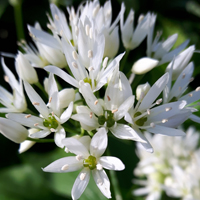 |
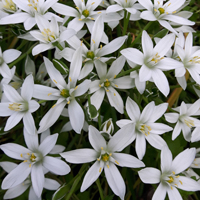 |
Umbellifers - Tight heads of five-petalled flowers opposite feathery leaves along the main stem
|
Heliotropes & Butterburs - Untidy heads of narrow flowers, usually appearing in winter or early spring, before the leaves
|
Onions & Garlics - Clusters of six-petalled flowers; leaves may smell of garlic
|
Common Star-of-Bethlehem - Several flowers in a spike, petals with green stripe on back
|
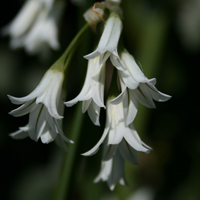 |
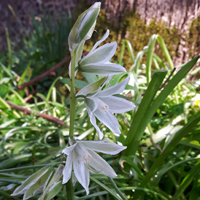 |
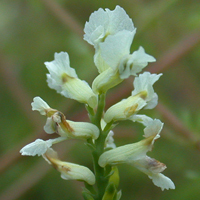 |
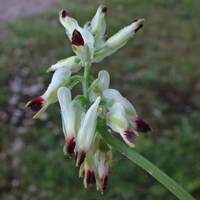 |
Onions & Garlics - Clusters of six-petalled flowers; leaves may smell of garlic
|
Drooping Star-of-Bethlehem - Several flowers in a spike, petals with green stripe on back
|
Climbing Corydalis - Loose heads of tubular flowers on a scrambling plant
|
Fumitories - Sprawling plants of open, disturbed ground or growing from walls
|
 |
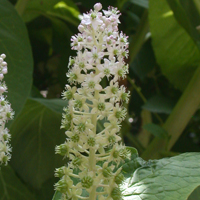 |
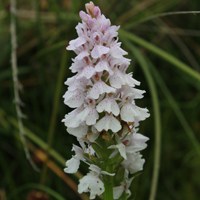 |
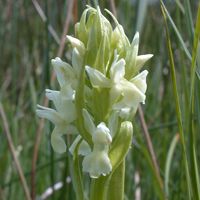 |
Spanish-dagger - Impressive, large clusters of six-petalled flowers, atop fleshy, sword-like leaves
|
Pokeweeds - Upright spikes of green-centred flowers on fleshy stems
|
Orchids - Dense spikes of showy flowers, often with pink markings
|
Orchids - Dense spikes of 'winged', whitish flowers
|
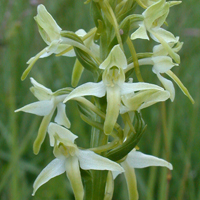 |
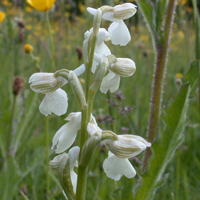 |
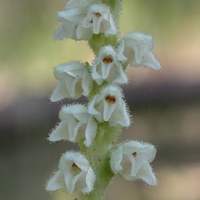 |
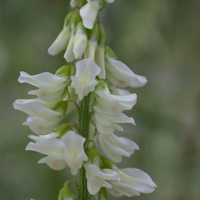 |
Orchids - Spikes of loosely-spaced, 'winged' flowers
|
Orchids - Spikes of loosely-spaced, 'winged' flowers
|
Lady's-tresses - Small, easily-missed spikes with flowers arranged in a spiral up the stem
|
Melilots - Narrow spikes of tubular flowers on spindly plants with trifoliate leaves
|
 |
 |
 |
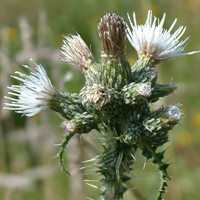 |
Dodders - Tight spirals of small, four-petalled flowers on reddish stems, twisting around other plants
|
Fringecups - Cream-coloured flowers with bristle-edged petals in narrow, upright spikes
|
Pellitory-of-the-wall - Masses of tiny red/green, petalless flowers with white tips, crowded at the leaf bases. On walls, cracks in pavement and similar places
|
Thistles - Flowerheads clustered together to form tight bundles of scales with 'fluffy' tops; plants spiny
|
 |
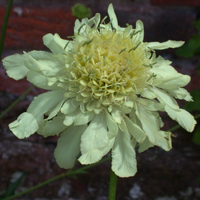 |
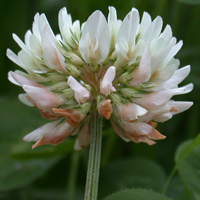 |
 |
Greater Masterwort - Many petal-like bracts around a head of many small flowers clustered in the centre
|
Scabiouses - Tight heads of many cream-coloured flowers, with the outer flowers having larger petals
|
Clovers - Dense, rounded heads of narrow, tubular flowers; leaves trifoliate
|
Clovers - Narrow, tubular flowers in a tight, rounded head on creeping plants with trifoliate leaves
|
 |
 |
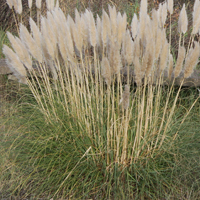 |
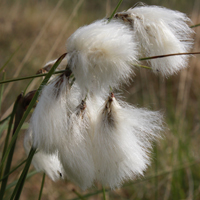 |
White Beak-sedge - Small, petalless flowers in a tight head above grass-like stems, rare in acid bogs
|
Bur-reeds - White 'pompoms' of petalless flowers in a spike, above sword-like stems, growing in water or very wet ground
|
Grasses - Grasses with feathery heads of many tiny florets
|
Cottongrasses - Fluffy heads on short stems, in acid bogs
|
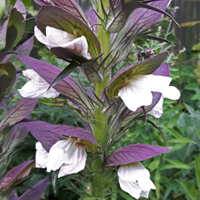 |
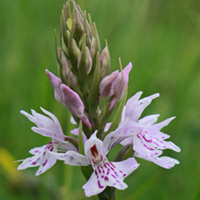 |
Bear's-breeches - Tubular flowers surrounded by a maroon-purple hood, in stout, upright spikes
|
Orchids - Dense, columnar or pointed spikes of pink flowers with darker spots on an enlarged, lower lip (labellum)
|
 |
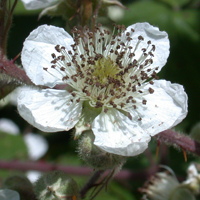 |
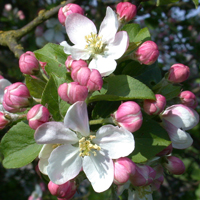 |
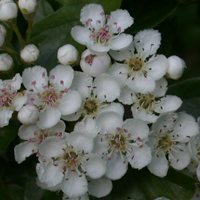 |
Roses - Showy, five-petalled flowers on thorny bushes
|
Brambles - Clusters of five-petalled flowers on thorny stems
|
Rose Family - Clusters of five-petalled flowers, often pink on the back, on bushes or small trees
|
Rose Family - Small bunches of five-petalled flowers with many stamens at the centre
|
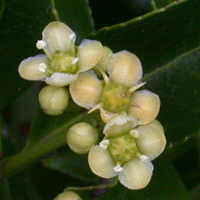 |
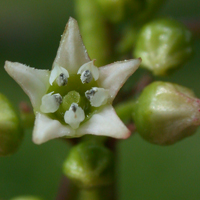 |
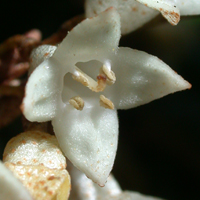 |
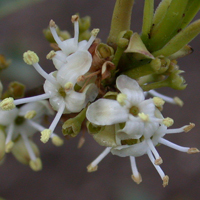 |
Spindles - Four-petalled flowers on evergreen shrubs
|
Alder Buckthorn - Clusters of small, five-petalled flowers on multi-stemmed bushes or small trees
|
Oleasters - Heavily-scented, four-petalled flowers on evergreen shrubs in winter
|
Hollies - Four-petalled flowers with prominent stamens on evergreen trees or bushes
|
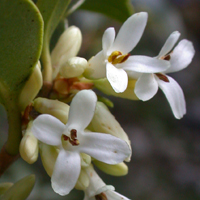 |
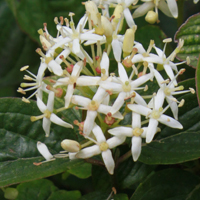 |
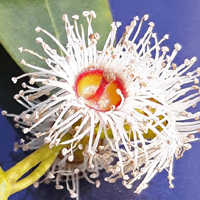 |
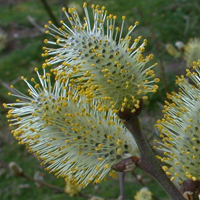 |
Privets & allies - Four-petaled flowers with tubular bases, in clusters
|
Dogwoods - Rounded clusters of four-petalled flowers on twiggy, spreading bushes
|
Eucalypts - Petalless flowers on large, evergreen trees, flowering in winter
|
Sallows - Tight clusters of greyish white, woolly, petalless flowers
|
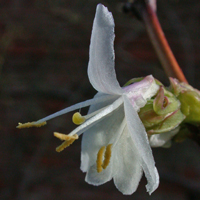 |
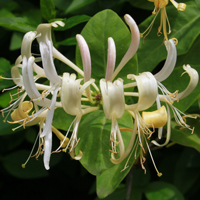 |
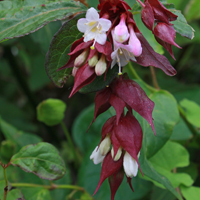 |
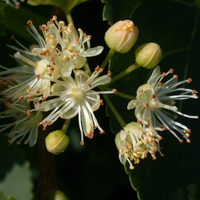 |
Honeysuckles - Heavily fragrant flowers on bare stems in winter/early spring
|
Honeysuckles - Heavily fragrant flowers twining climbers
|
Honeysuckle family - Five-petalled flowers, surrounded by maroon-coloured bracts
|
Limes - Hanging clusters of flowers on large trees
|
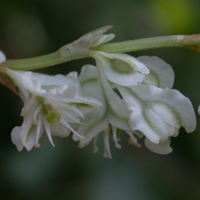 |
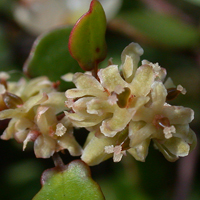 |
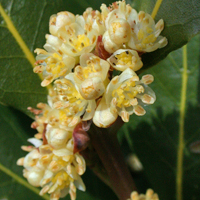 |
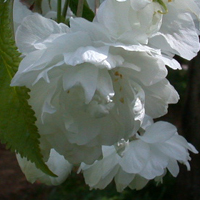 |
Russian-vine - Clusters of pendant flowers on aggressive climbing plants
|
Wireplant - Small bunches of cream-coloured or off-white flowers on blackish, wiry, climbing or rambling stems
|
Bay Laurel - Tight bundles of creamy flowers among leathery, evergreen leaves
|
Cherries - Spring-flowering trees with 'pompom' flowers bearing many petals
|
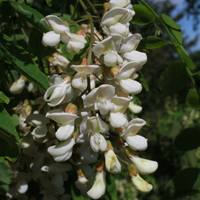 |
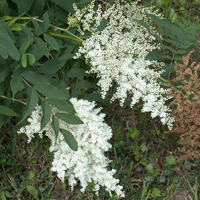 |
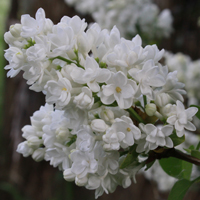 |
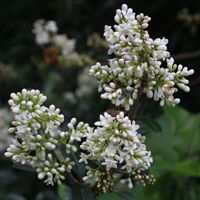 |
Black Locust - Thorny trees with compound leaves and hanging bunches of 'pea' flowers
|
Sorbarias - Large 'frothy' heads of many small flowers; pinnate leaves
|
Lilacs - Large, showy, fragrant heads of four-petalled flowers on suckering large shrubs or small trees.
|
Privets & allies - Four-petaled flowers with tubular bases, in showy clusters
|
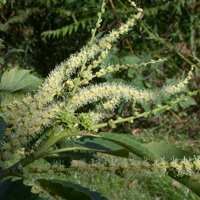 |
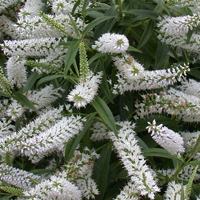 |
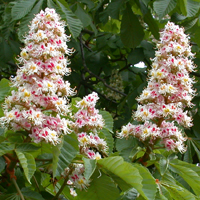 |
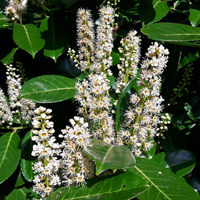 |
Sweet Chestnut - Long, slender spikes of many, tiny, cream-coloured flowers
|
Hebes - Long or short spikes of showy clusters of four-petalled flowers
|
Horse Chestnuts - Tall, candelabra flowers on large trees with fingered leaves
|
Cherries - Evergeen or deciduous trees or shrubs with white flowers carried in elongated spikes
|
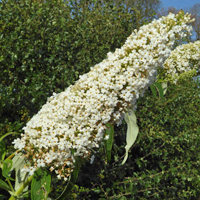 |
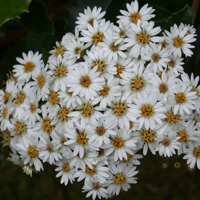 |
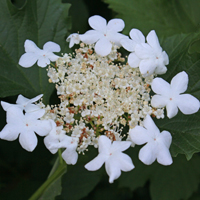 |
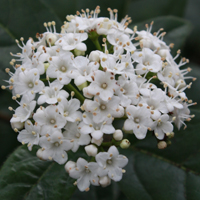 |
Butterfly-bushes - Open-branched, many-stemmed bushes with clusters of many, tubular flowers in long spikes
|
Daisy-bushes - Evergreen bushes with showy heads of daisy-like flowers
|
Guelder-rose - Flattened rosettes of flowers, with fertile florets in the centre and sterile florets with large, petal-like bracts around the outside
|
Viburnums - Rounded, showy clusters of five-petalled flowers
|
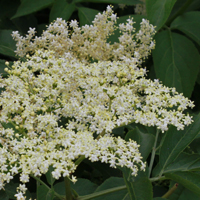 |
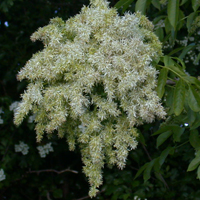 |
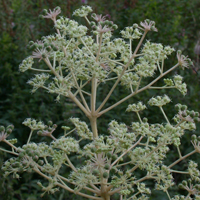 |
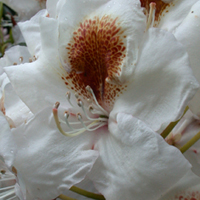 |
Elders - Flattened heads of creamy, five-petalled flowers
|
Manna Ash - Large, frothy heads of creamy-white flowers on trees with pinnate leaves
|
Angelica-trees - Spiny-stemmed shrubs with huge, twice-pinnate leaves
|
Rhododendrons - Spreading, evergreens with large, leathery leaves and tight clusters of large, showy flowers
|
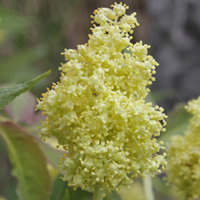 |
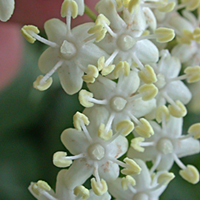 |
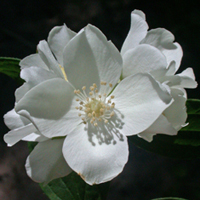 |
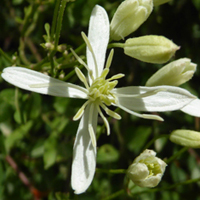 |
Elders - Rounded heads of creamy, five-petalled flowers
|
Elders - Flattened heads of creamy, five-petalled flowers
|
Mock-oranges - Fragrant flowers on thornless, multi-stemmed shrubs with thin and wiry branches. Leaves simple, in opposite pairs
|
Clematis - Highly fragrant, pure white flowers on rampant climbers with only one whorl of petal-like 'tepals'
|
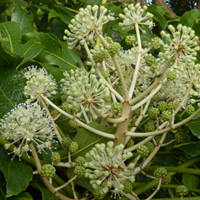 |
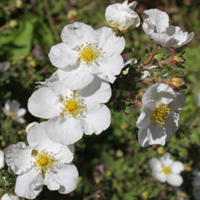 |
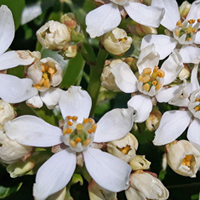 |
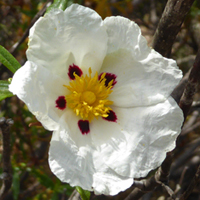 |
Japanese Fatsia - Spreading, evergreen shrubs with large, glossy, palmately-lobed leaves
|
Shrubby Cinquefoil - A dense-branched, low shrub, the hairy leaves with five leaflets
|
Mexican Orange-blossom - Evergreen bushes with spicy-scented, trifoliate leaves and highly aromatic flowers
|
Gum Rock-rose - Evegreen shrubs with sticky leaves and flowers with tissue-like, crumpled petals
|
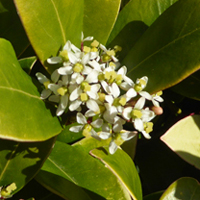 |
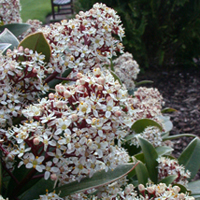 |
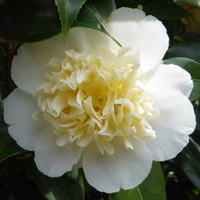 |
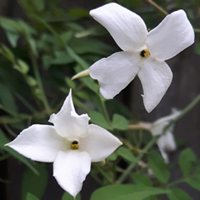 |
Japanese Skimmia - Evergreen bushes with leathery leaves and highly aromatic flowers
|
Japanese Skimmia - Evergreen bushes with leathery leaves and highly aromatic flowers
|
Japanese Camellia - Evergreen bushes with leathery leaves and large, showy flowers in red, white or pink
|
Summer Jasmine - Scrambling climbers with pinnate leaves and clusters of 4- to 6-lobed flowers
|
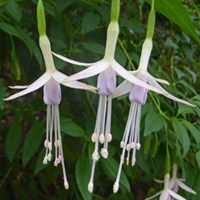 |
Fuchsias - Hanging flowers with very long stamens; various shades of red or pink with purple or white
|